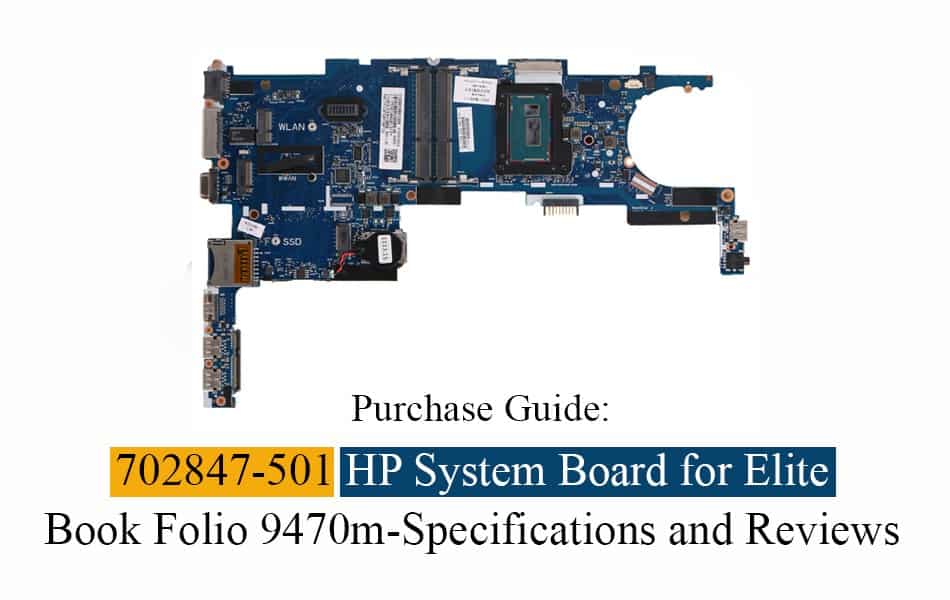Purchase Guide: 702847-501 – HP System Board for Elite Book Folio 9470m – Specifications and Reviews
Choosing a suitable motherboard is the primary factor in determining the fate of the compatibility of your hardware components. People focus more on choosing the best GPU and CPU while neglecting this crucial aspect and face troubles. Every component of your PC must plug into the motherboard you opt for. Its compatibility and size translate into your final product and how many components you can add later. The chipset/processor socket determines what kind of CPU you can install.
Things to Remember
- Budget Factor—If overclocking is not your cup of tea, you can easily get a decent motherboard for less than $150. Otherwise, you need PCIe 4.0 or a lot of ports on your motherboard, which is available for more than $200. The prices may vary for desktop and laptop motherboards.
- Additional Features—There is no need to spend extra pennies on built-in Wi-Fi or high-end ports unless you need them. You can use a wired connection better to save money and invest in other components. For a futuristic approach, you can acquire a system board with USB 3.1 Gen 2 and/or Thunderbolt 3 support and PCIe 4.0.
Let’s discuss some crucial factors that constitute your motherboard’s compatibility equation.
Which chipset are you going to deploy?
The CPU you’ll deploy on your board can filter out many options because the CPU socket on a specific motherboard only shows compatibility with the processor lineup it was designed for.
Suppose you buy an Intel 10th or 11th Generation CPU, requiring a motherboard with an LGA 1200 socket. Previous 9th-generation chips are compatible with an LGA 1151 socket. AMD made this process less confusing by using the AM4 socket for its current-gen lineup of processors (from Athlons to 16-core Ryzen 9). On the other hand, Intel has recently featured immense variation by altering the course of socket compatibility from one generation to the next. It has finally refrained from going further into complexities by maintaining the Socket 1200 standard for the last two generations. The 702847-501 – HP System Board for Elite Book Folio 9470m socket has built-in 3rd Gen Intel processors with Intel’s QM77 chipset.
PS: The compatibility of the chips above is not absolute, as high-end models (both Intel and AMD) have compatibility with different sockets to accommodate the bigger size and power consumption of their Core X and Thread Ripper lineup of processors.
Variety of Ports
You should check your motherboard’s I/O interface to ensure an external connection is present, which you may need later. Do not forget to check the motherboard’s USB headers, which will allow you to add more ports using a front-panel connection on your PC case or less expensive expansion slot brackets at the back.
Below is the list of commonly used ports and their usage.
- Gen 1 USB 3 – Also known as USB 3.1, works with most devices
- Gen 1 USB 2 – Slower than USB 3 but serves well for keyboards, mice, and other peripherals
- Gen 2 USB 3.1 or 3.2 – Not many peripherals are compatible with this standard yet. It delivers 10 GB/s of transfer rate, twice the bandwidth of USB 3.1 Gen 1 or USB 3.0. USB 3.2 Gen2 (2×2) doubles the transfer rate again due to two 10 GB/s transfer lanes. You can hardly find only one of these ports on high-end motherboards.
- USB Type-C—These ports can either show compatibility with USB 3.1 Gen 1 or USB 3.1 Gen 2 and are introduced for newer devices such as the latest Android or Apple smartphones. A few of them are just USB 2.0 but often get titled as Audio USB-C ports to connect USB-C headphones.
- HDMI—You only need an HDMI port if you are going to use integrated graphics. Third-party GPUs, such as those of Nvidia and AMD, feature their own video ports.
- Audio ports – Used to connect audio devices such as speakers or headphones
- PS/2 ports – Not in use today. They provide pin-based connectivity with old-school keyboards and mice.
- Thunderbolt – This connectivity interface is very expensive and rare to find as an integrated motherboard chip, and very few motherboards support it through dedicated add-on cards. This connectivity standard offers the fastest possible connections of up to 40 GB/s.
Connectivity interfaces in 702847-501 – HP System Board for Elite Book Folio 9470m
702847-501 – HP System Board for Elite Book Folio 9470m features:
- Three USB 3.0 Port
- A DisplayPort
- SD/MMC Reader
- VGA
- Docking port
- Ethernet Port (also known as LAN port)
- mSATA slot (smaller form factor than a standard SSD and is introduced for use with portable, power-friendly devices such as laptops and tablets)
- Built-in Bluetooth
RAM Slots
The importance of this aspect can be determined by the fact that the number of slots on your board can limit the number of RAM cards you can install now. Normally, laptop motherboards feature two to four RAM slots (compact Mini-ITX models are exceptions to having just two RAM slots).
For mainstream workloads and games, 16GB of RAM is sufficient, and 32GB is more than enough, even with just two slots.
The number of pins differs between DDR2, DDR3, DDR4, DDR5, and DDR6 memory modules. Inserting your RAM strip in the wrong slot can damage it. Read your board’s specs to ensure which type of DDR module it is intended to support. 702847-501 – HP System Board for Elite Book Folio 9470m motherboard features two DDR3 (240 Pins) DIMM memory slots.
